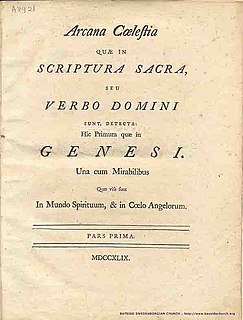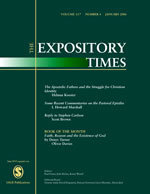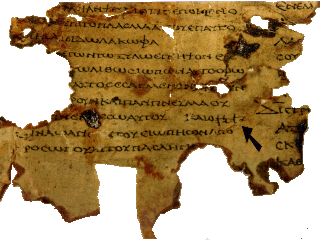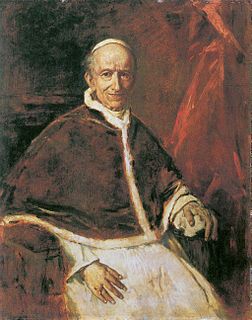 W
WBiblical studies is the academic application of a set of diverse disciplines to the study of the Bible. For its theory and methods, the field draws on disciplines ranging from archaeology, ancient history, cultural anthropology, textual criticism, literary criticism, historical backgrounds, mythology, and comparative religion.
 W
WThe Arcana Cœlestia, quae in Scriptura Sacra seu Verbo Domini sunt, detecta, usually abbreviated as Arcana Cœlestia or under its Latin variant, Arcana Cælestia, is the first and largest work published by Emanuel Swedenborg in his theological period. It was written and published in Neo-Latin, in eight volumes, one volume per year, from 1749 to 1756.
 W
WBiblical criticism is the discipline of attempting to understand and explain the intended meaning of biblical texts using critical analysis of the Bible. In its first form, it began in the eighteenth century as historical-biblical criticism. This original form of criticism was based on two distinguishing perspectives: the scientific concern to avoid dogma and bias by applying a neutral, non-sectarian, reason-based judgment to the study of the Bible, and the belief that reconstructing the historical events behind the texts, as well as the history of how the texts themselves developed, would lead to correct understanding. This foundation set it apart from: earlier, pre-critical methods, the anti-critical methods of those who oppose criticism-based study, later post-critical orientation, and the many different types of criticism which biblical criticism transformed into in the late twentieth and early twenty-first centuries.
 W
WThe chronology of the Bible is an elaborate system of lifespans, 'generations', and other means by which the passage of events is measured, beginning with the Genesis creation narrative. A widespread scholarly understanding is that this marks out a world cycle of 4,000 years, ending, presumably, around 164 BCE. It was theological in intent, not historical in the modern sense. It also functions as an implied prophecy, whose key lies in the identification of the final event.
 W
WThe oldest surviving Hebrew Bible manuscripts—including the Dead Sea Scrolls—date to about the 2nd century BCE (fragmentary) and some are stored at the Shrine of the Book in Jerusalem. The oldest extant complete text survives in a Greek translation called the Septuagint, dating to the 4th century CE. The oldest extant manuscripts of the vocalized Masoretic Text, date to the 9th century CE. With the exception of a few biblical sections in the Prophets, virtually no biblical text is contemporaneous with the events it describes.
 W
WThe Expository Times is a long-established academic journal of biblical studies, theology, and ministry established in 1889 by the Scottish theologian James Hastings. The journal is abstracted and indexed in the ATLA Religion Database, New Testament Abstracts and the Arts and Humanities Citation Index. The current Executive Editor is Guy Bennett-Hunter.
 W
WThe historical-grammatical method is a Christian hermeneutical method that strives to discover the biblical authors' original intended meaning in the text. According to the historical-grammatical method, if based on an analysis of the grammatical style of a passage, it appears that the author intended to convey an account of events that actually happened, then the text should be taken as representing history; passages should only be interpreted symbolically, poetically, or allegorically if to the best of our understanding, that is what the writer intended to convey to the original audience. It is the primary method of interpretation for many conservative Protestant exegetes who reject the historical-critical method to various degrees, in contrast to the overwhelming reliance on historical-critical interpretation in biblical studies at the academic level.
 W
WThe internal consistency of the Bible concerns the coherence and textual integrity of the Bible. Disputes regarding biblical consistency have a long history.
 W
WThe kaige revision, or simply kaige, is the group of revisions to the Septuagint made in order to more closely align its translation with the proto-Masoretic Hebrew. The name kaige derives from the revision's pervasive use of Koinē Greek: και γε [kai ge] to translate the Hebrew: וְגַם [wə gam]. The importance of this revision lies in its status as a precursor to later revisions by 'the Three' as well as the light it sheds on the origins of the Septuagint.
 W
WThe Kenite hypothesis proposes that the origins of Yahweh, and by extension Yahwism, do not lie in Canaan as the Hebrew Bible describes, but instead originated in the area immediately south of the Levant, possibly extending far into the northwest Arabian Peninsula, on the east shore of the Gulf of Aqaba on the Red Sea, in the area the Tanakh calls "Midian". The theory states that Yahweh originally was a Midianite deity, who through trade made his way up north to the proto-Israelites. Another theory is that a confederation of regional tribes were connected to monotheistic ritual at Sinai.
 W
WIn historical-critical analysis, the L source is an hypothetical oral tradition which Luke may have used when composing his gospel. It includes the virgin birth of Jesus and many of Jesus' best loved parables. Like Matthew's unique source, known as M, the L source has important parables. Two which appear in L are the Good Samaritan and the Prodigal Son. I. Howard Marshall states "Luke rightly regarded these sources as reliable".
 W
WBiblical languages are any of the languages employed in the original writings of the Bible. Partially owing to the significance of the Bible in society, Biblical languages are studied more widely than many other dead languages. Furthermore, some debates exist as to which language is the original language of a particular passage, and about whether a term has been properly translated from an ancient language into modern editions of the Bible. Scholars generally recognize three languages as original biblical languages: Hebrew, Aramaic, and Koine Greek.
 W
WThe Literary Imagination in Jewish Antiquity is a monograph by Eva Mroczek, a scholar of ancient Judaism. Published by Oxford University Press in 2016, it argues that modern concepts of the Bible and even of the book itself—which refer to texts that are generally stable, finalized and/or definitive—are inapplicable to the Second Temple era of Judaism. The book suggests that scholars should avoid employing contemporary ideas of authorship in their studies of early Jewish texts.
 W
WThe "New Perspective on Paul" represents a significant shift in the field of biblical studies since the 1970s in the understanding of the writings of the Apostle Paul, due to E. P. Sanders' pioneering 1977 work Paul and Palestinian Judaism.
 W
WProvidentissimus Deus, "On the Study of Holy Scripture", was an encyclical letter issued by Pope Leo XIII on 18 November 1893. In it, he reviewed the history of Bible study from the time of the Church Fathers to the present, spoke against the errors of the Rationalists and "higher critics", and outlined principles of scripture study and guidelines for how scripture was to be taught in seminaries. He also addressed the issues of apparent contradictions between the Bible and physical science, or between one part of scripture and another, and how such apparent contradictions can be resolved.
 W
WJoseph Ernest Renan was a French Orientalist and Semitic scholar, expert of Semitic languages and civilizations, historian of religion, philologist, philosopher, biblical scholar and critic. He is best known for his influential and pioneering historical works on the origins of early Christianity, and his political theories, especially concerning nationalism and national identity. Renan is credited as being among the first scholars to advance the now-discredited Khazar theory, which held that Ashkenazi Jews were descendants of the Khazars, Turkic peoples who had adopted Jewish religion and migrated to Western Europe following the collapse of their khanate.
 W
WGary A. Rendsburg is a professor of biblical studies, Hebrew language, and ancient Judaism at Rutgers University in New Brunswick, New Jersey. He holds the rank of Distinguished Professor and serves as the Blanche and Irving Laurie Chair of Jewish History at Rutgers University (2004–present), with positions in the Department of Jewish Studies and the Department of History.
 W
WIn biblical studies, the supplementary hypothesis proposes that the Pentateuch was derived from a series of direct additions to an existing corpus of work. It serves as a revision to the earlier documentary hypothesis, which proposed that independent and complete narratives were later combined by redactors to create the Pentateuch.
 W
WWisdom literature is a genre of literature common in the ancient Near East. It consists of statements by sages and the wise that offer teachings about divinity and virtue. Although this genre uses techniques of traditional oral storytelling, it was disseminated in written form.